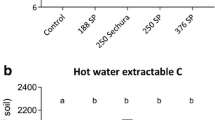Abstract
The impact of two tillage systems, plow tillage (PT) and no-tillage (NT), on microbial activity and the fate of pesticides in the 0–5 cm soil layer were studied. The insecticides carbofuran and diazinon, and the herbicides atrazine and metolachlor were used in the study, which included the incubation and leaching of pesticides from untreated soils and soils in which microorganisms had been inhibited. The mineralization of ring14C labeled pesticides was studied. The study differentiated between biotic and abiotic processes that determine the fate of pesticides in the soil. Higher leaching rates of pesticides from PT soils are explaned by the relative importance of each of these processes. In NT soils, higher microbial populations and activity were associated with higher mineralization rates of atrazine, diazinon and carbofuran. Enhanced transformation rates played an important role in minimizing the leaching of metolachlor and carbofuran from NT soils. The role of abiotic adsorption/retention was important in minimizing the leaching of metolachlor, carbofuran and atrazine from NT soils. The role of fungi and bacteria in the biodegradation process was studied by selective inhibition techniques. Synergistic effects between fungi and bacteria in the degradation of atrazine and diazinon were observed. Carbofuran was also degraded in the soils where fungi were selectively inhibited. Possible mechanisms for enhanced biodegradation and decreased mobility of these pesticides in the upper layer of NT soils are discussed.
Similar content being viewed by others
References
Arshad, M. A., Schnizer, M., Angers, D. A., and Ripmeester, J. A.: 1990,Soil Biol. Biochem. 22 (5), 595.
Bartha, R. and Pramer, D.: 1965,Soil Sci. 100 (1), 68.
Bollag, J. M.: 1990, ‘Biotransformation of the Herbicide Metolachlor’, in G. E. Pierce, (ed.),Developments in Industrial Microbiology, Vol 31 Suppl. No. 5.Soc. Indus. Micro.
Bollag, J. M. and Liu, S. Y.: 1990, ‘Biological Transformation Processes of Pesticides’, inPesticides in the Soil Environment. Soil Sci. Soc. Amer. Book Series No. 2, pp. 169–211.
Bremner, J. M.: 1965, ‘Total Nitrogen’, in C. A. Black, (ed.),Methods of Soil Analysis, Ist Ed. Part II Chemical and microbiological properties, Agronomy 9:1149–1178.
Chaudry, G. R. and Ali, A. N.: 1988,Appl. Environ. Microbiol. 54 (6), 1414.
Cook, A. M.: 1987,FEMS Microb. Rev. 46, 93.
Dick, W. A. and Daniel, T. C.: 1987, ‘Soil chemical and Biological Properties as Affected by Conservation Tillage: Environmental Implications’, in T. J. Logan, J. M. Davidson, J. L. Baker and M. R. Overcash, (eds.),Effects of Conservation Tillage on Groundwater Quality, Lewis Inc., Chelsea, Michigan, U.S.A., pp. 125–147.
Doran, J. W.: 1982, ‘Tillage Changes Soil’,Crops and Soils Magazine, Aug.–Sept. 1982, pp. 10–12.
Doran, J. W.: 1987,Biology and Fertility of Soils 5, 68.
Karns, J. S., Mulbry, W. W., Nelson, J. O., and Kearny, P. C.: 1986,Pest. Biochem. and Biphysiol. 22 (5), 685.
Kaufman, D. D. and Kearney, P. C.: 1976, ‘Microbial Transformations in the Soil’, in L. J. Audus (eds.),Herbicides: Physiology, Biochemistry, Ecology Vol. II, 2nd Ed. Academic Press, London, U.K., pp. 29–64.
Kinsbursky, R. S., Levanon, D., and Yaron, B.: 1989,Soil Sci. Soc. Am. J. 53 (4), 1086.
Levanon, D., Codling, E. E., Meisinger, J. J., and Starr, J. L.: 1993, ‘Mobility of Agrochemicals Through Soil from Two Tillage Systems’,J. Environ. Qual. 22, 155.
Logan, T. J., Davidson, J. M., Baker, J. L., and Overcash, M. R., (eds.): 1987,Effects of Conservation Tillage on Ground Water Quality, Lewis Inc. (Publ.), Chelsea, Michigan, U.S.A.
Metzger, L., Levanon, D., and Mingelgrin, U.: 1987,Soil Sci. Soc. Am. J. 51, 346.
Ocio, J. A. and Brooks, P. C.: 1990,Soil Biol Biochem. 22 (5), 685.
Ramanand, K., Sharmila, M., and Sethunathan, N.: 1988,Appl. Environ. Microbiol. 54 (8), 2129.
Shoemaker, L. L., Magette, W. L., and Shirmohammadi, A.: 1990,Modeling Management Practice Effects on Pesticide Movement to Ground Water, Sci. Article No. A-4985, Contribution No. 8030. Agric. Exp. Stn., Univ. of MD, College Park, MD, U.S.A.
Smith, M. S. and Blevins, R. L.: 1987, ‘Effect of Conservation Tillage on Biological and Chemical Soil Conditions: Regional and temporal Variability’, in T. J. Logan, J. M. Davidson, J. L. Baker and M. R. Overcash (eds.),Effects of Conservation Tillage on Ground Water Quality. Lewis, Inc., Publ., Chelsea, Michigan, U.S.A., pp. 149–166.
Turco, R. F. and Konopa, A.: 1990,Soil Biol. Biochem. 22 (2), 1195.
Author information
Authors and Affiliations
Rights and permissions
About this article
Cite this article
Levanon, D., Meisinger, J.J., Codling, E.E. et al. Impact of tillage on microbial activity and the fate of pesticides in the upper soil. Water Air Soil Pollut 72, 179–189 (1994). https://doi.org/10.1007/BF01257123
Received:
Accepted:
Issue Date:
DOI: https://doi.org/10.1007/BF01257123




